Pump Selection Guide
Long-life, Precision Pumps for Your Fluidic System
Reduce downtime and move fluids precisely in your system with pumps from IDEX Health & Science
We engineer standard and customized solutions to handle your high-throughput demand. Whether your application calls for pumping deionized water or high salinity, detergent-containing fluids, our reliable motorized pistons consistently deliver liquids for your unique application. From conventional diagnostic devices to modern molecular platforms, with IDEX Health & Science pumps, you can confidently implement sophisticated fluid actuation sequences while de-risking your development efforts.
Features:
- Superior chemical resistance
- Long lifetime
- Outstanding precision and accuracy
Applications:
- Clinical chemistry and similar applications
- Immunoassay, flow cytometry, next generation sequencing, etc.
- Chemically demanding molecular application
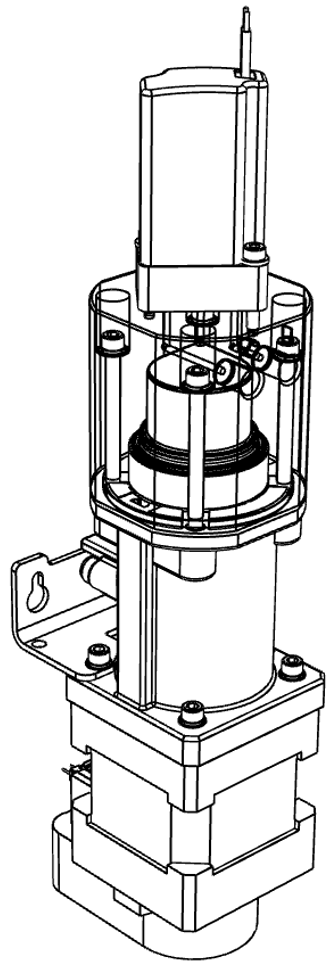
How it Works
IDEX Health & Science manufactures high precision motorized pistons and pumps. We offer a unique combination of materials, designs, and manufacturing processes that provide you with a reliable and precise fluid actuator for your system.
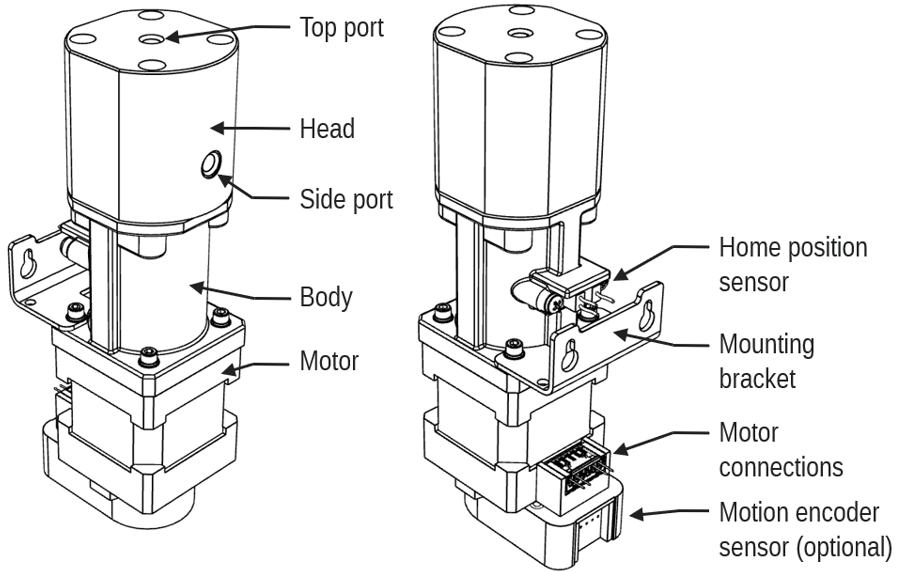
Actuator Design
Our motorized piston pump consists of three primary sections: the head, the body, and the motor.
The head is the fluidic interface of the piston. Here the piston comes in contact with fluids and displaces them. High-performance seals in the pump head prevent fluids from entering the body. The body houses a precision drive train that converts the rotary motion of the motor into a linear displacement of fluids.
Position and optional motion feedback enable you to achieve a higher level of fluid actuation control by allowing you to account for load-related offsets. Electrical interfaces and mounting are located 180° from the fluidic ports, to avoid spill-over when handling the product.
Precision & Accuracy
Our products are designed to displace fluids with a high degree of accuracy and precision. We achieve this using long-life stepper motors, specifically designed for axial loads, coupled to a high-precision drive train. The stepper motor ensures precise positioning of the piston when controlled by conventional motor driver-controllers. An ultrasmooth ceramic piston with tight tolerances lowers dynamic friction, while the engineered seal provides the dampening for reduced resonance under load. These factors lead to precision of <± 0.5% for a ≥ 2% full scale displacement under controlled conditions.
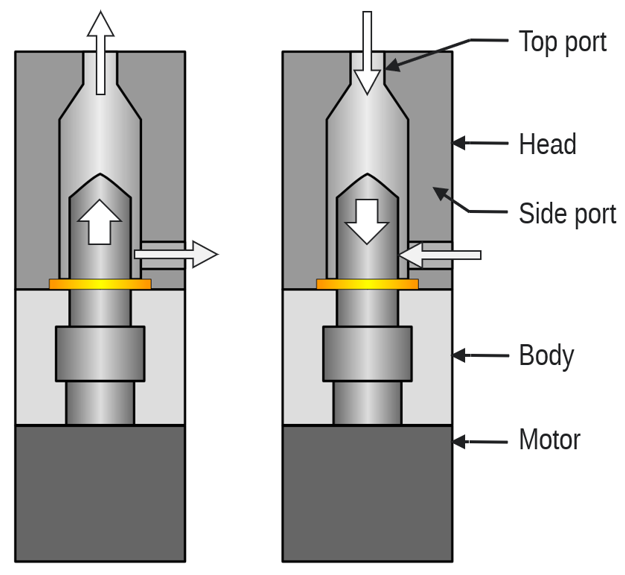
Long Life & Reliability
We understand that component lifetime and reliability is of paramount importance to instrument developers. We offer many engineered combinations to calibrate pumping for your specific needs.
It starts with the choice of materials that includes ultra-smooth-processed ceramics for pistons, and chemically inert and abrasive-resistant polymers for seals. The piston does not contact the walls of the pump head, limiting friction to the piston-seal interaction. These factors reduce your preventive maintenance frequency.
Engineers looking for additional reliability have the option to incorporate a seal wash into their design. Through flowing a flush liquid into the back of the piston, the seal wash prevents premature chemical degradation and wear.
The stepper motor and the drive train are designed to run reliably for the life of the instrument, eliminating electromechanical risk factors and unnecessary downtime for repair or exchange.
Customization
Adapting the pump to your application and operational requirements is simplified through our available customization choices.
Adjusting the pump’s chemical resistance is achieved through multiple pump head and piston seal options. Dynamics optimization can be achieved by various motor wiring configurations and drive train options. Electrical connections, sensor output, mounting, and fluid port locations can be adjusted to your needs simplifying your integration design work.
Fluidic Integration
In many fluidic applications, pumps are used inline to facilitate priming and bubble clearance. For example, in a typical clinical laboratory instrument, our pumps work best when they manage the high precision side of fluid actuation while lower cost pumps are used for priming (shown below).
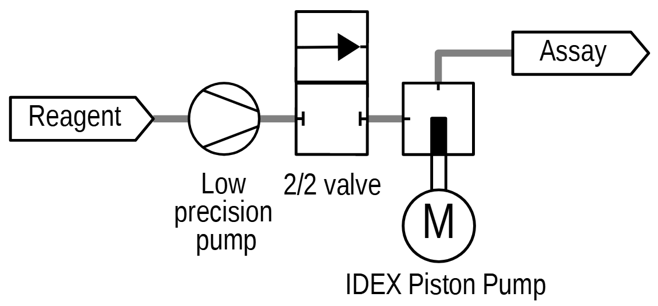
Self-priming can be achieved for instance by adding a 3/2 valve to the product yielding a configuration that provides one-directional (shown below).
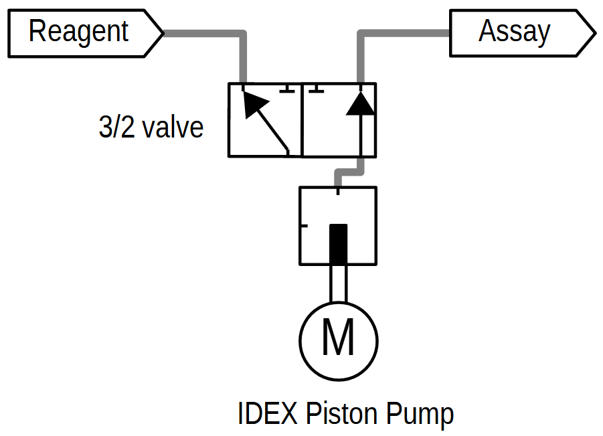
A convenient level of further integration can be achieved by adding either a single or multiple valves to the pump head (Figure 1).
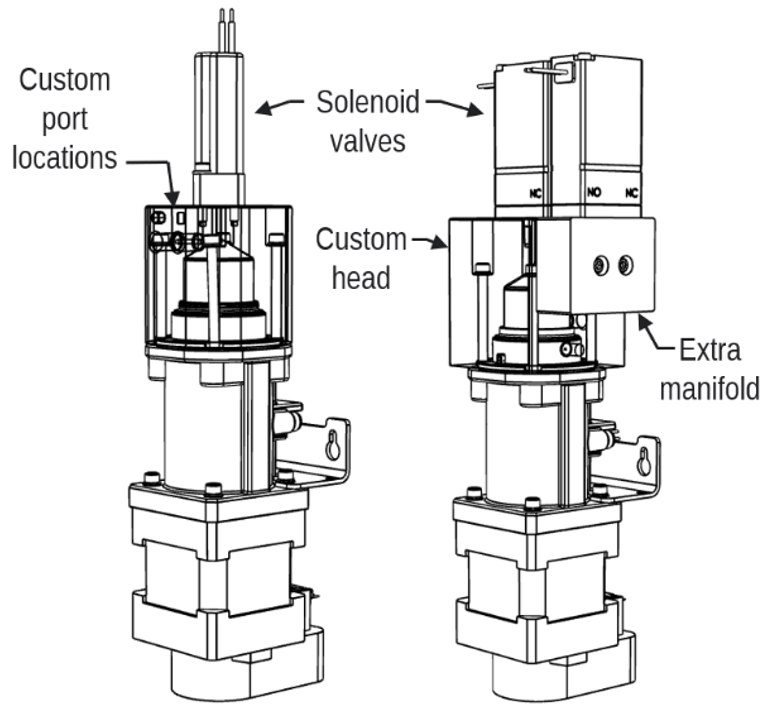
Figure 1: Two examples for the addition of extra functionality to pump heads. The left model shows the addition of a single solenoid valve to the head. The right model uses a different head form with a solenoid valves.
For the implementation of complex fluidic networks and functionalities that improve your system throughput while reducing reagent consumption and carryover, IDEX Health & Science offers a higher-level integration when combining our piston pumps with our rotary shear valves, pressure sensors, and other components in multi-layer manifolds as shown in Figure 2.
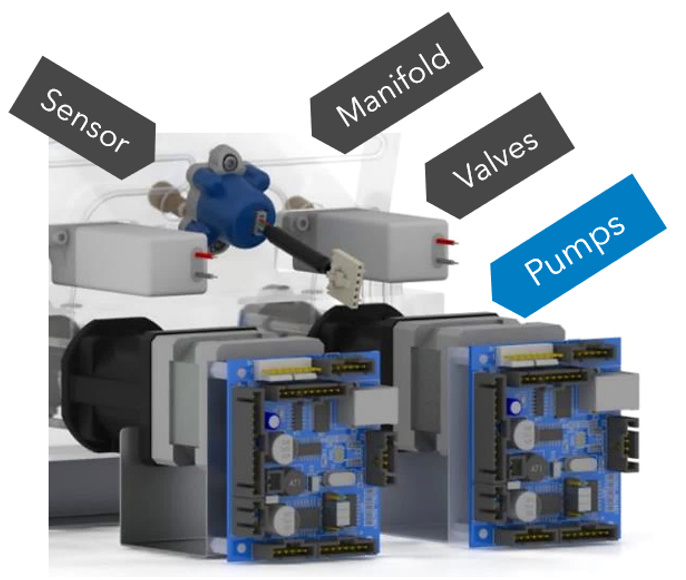
Figure 2: Example for the integration of pumps with solenoid valves and pressure sensors on a manifold manufactured at our Bristol, CT facility.
Development & Testing
IDEX Health & Science employs a robust, data-driven development process to deliver products tailored for your application. Our careful engineering approach pays attention to more than just the piston, seal, and electromechanical design. We complement our products with extensive testing to ensure reliability and performance.
Testing multiple pump parameters independently, or as part of extensive life test populations, provides you with demonstrated instrument reliability. Our life-test methods use commercially available reagent preparations, or your unique reagent blend to provided confidence in product performance.
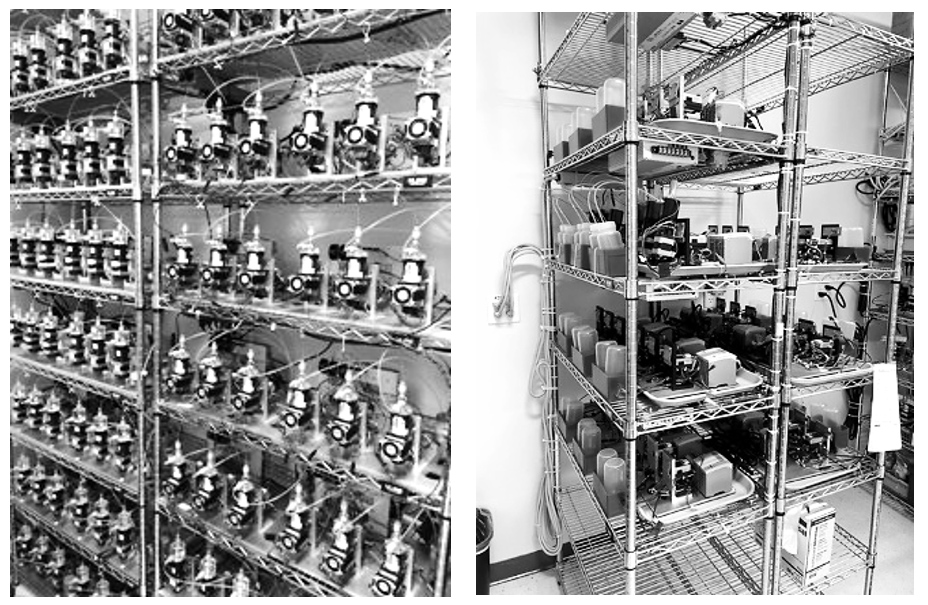
Figure 3. Example of pump testing setups in our Middleboro, MA facility. The left image shows multiple molded head pumps on life test achieving multiple millions of cycles. The right image shows the testing of a durable VFP17-DRB model using high saline and detergent-containing reagents.
Operational Excellence
Our Manufacturing Operations, Quality, Purchasing, and Planning groups are a part of our development teams and work together to transfer pump specifications into the production environment. We use documented and controlled work processes, automated test equipment, and verify the product’s value stream to ensure consistent and high-quality products. This also allows us to control your cost targets throughout the project and during continuous production.
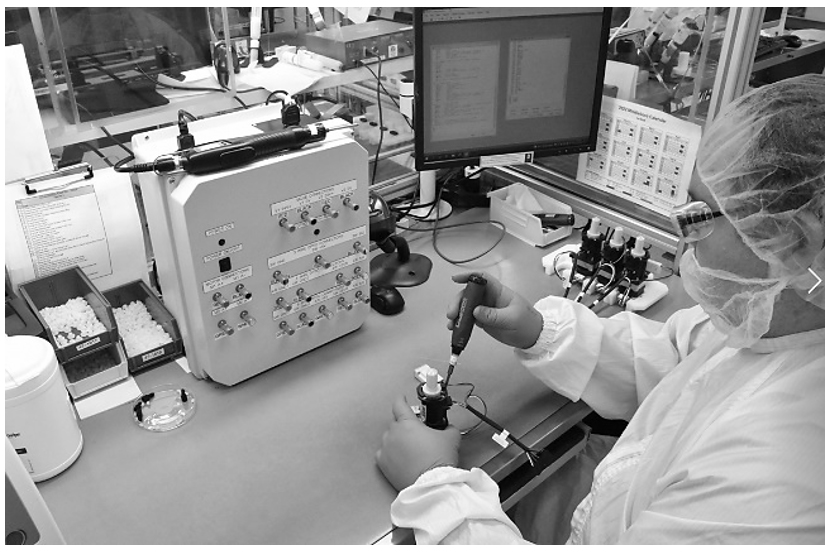
Figure 4: Our highly skilled production team led by knowledgeable and experienced manufacturing and quality engineers assemble and test pumps in our Class 1000 (ISO Class 6) environments. Our focus is ensuring that you get a high-quality product, manufactured to the highest workmanship standards.
Standard Pump Series
Our standard pump offering provides you with a wide range of flexibility to build your instrument. A team of dedicated engineers can help you customize your pump to meet the specific needs of your application. For whichever design configuration you select, IDEX Health & Science offers you confidence in lifetime, quality, consistency, and precision for your fluidic application.
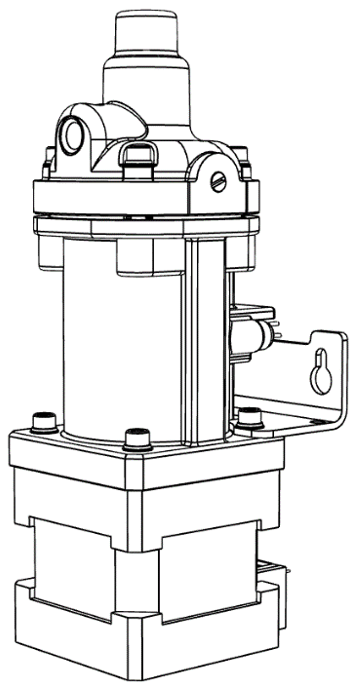
V17 Series
Implement precision at controllable cost
- Combines reliability with cost-consciousness in lower throughput instruments
- Provides high precision and accuracy in hydraulic actuation using deionized water
- For use where media is actuated via deionized water as hydraulic fluid
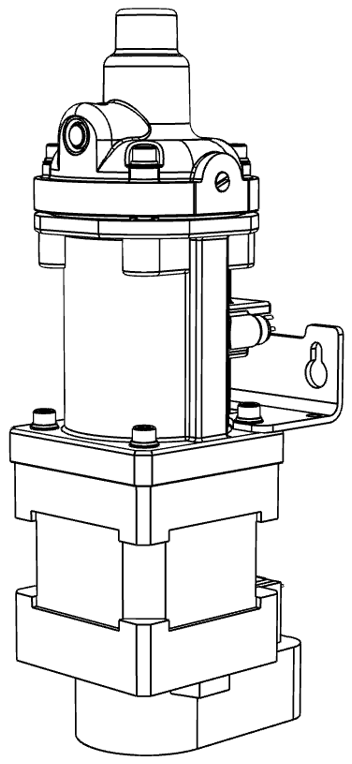
VP17 Series
Improves throughput and life while maintaining performance
- Offers high reliability, for millions of cycles
- Enables high throughput
- Ensures life-long high precision and accuracy
- Adapts to your system by customizing sensor feedback, electrical connections, and mounting options
- For use in clinical chemistry and comparable assay systems
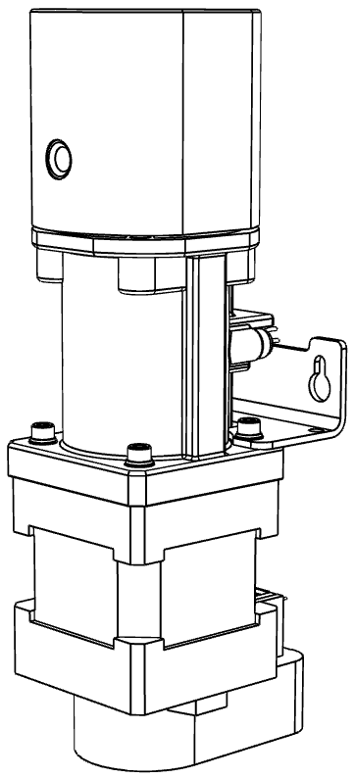
VFP17 Series
Added chemical resistance, ease of integration, and extra performance features
- Improved chemical resistance options using resistant materials, or seal wash features when dealing with aggressive media
- Maintains performance when working with demanding chemistry
- Additional functions (valving and pressure sensing) can be integrated
- For use in molecular assay platforms
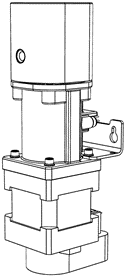
VFP17-DRB Series
Manage high-salinity and detergent-containing chemistries with high performance
- Provides reliability and reduces downtime in your molecular detection or processing platform
- Improves throughput and performance using an actuator in each reagent line
- Turn the actuator into a subsystem by customizing and adding extra features
- For use in higher throughput molecular platforms
Overview of Pump Series
| Parameter | V17 | VP17 | VFP17 | VFP17-DRB |
| Expected piston cycle lifetime1 | > 2 M | > 5 M | > 5 M | > 1.5 M |
| Chemical compatibility | Deionized water, low salinity, moderate pH aqueous solutions | Deionized water, low salinity, moderate pH aqueous solutions | Higher chemical resistance than V17 and VP17 series2 | Handles saline and detergent-containing fluids |
| Piston displacement precision3 | < ±1.0% | < ±1.0% | < ±0.75% | < ±0.75% |
| Static pressure tolerability4 | < 100 psi | < 100 psi | < 500 psi | < 500 psi |
| Displacement size (μL)5 | 100, 500, 1000 | 100, 500, 1000 | 25, 50, 100, 250, 500, 1000, 2500, 5000 | 250, 2500, 5000 |
| Fluidic ports | ¼-28 UNF, M6 | ¼-28 UNF, M6 | ¼-28 UNF, M6, and custom | ¼-28 UNF, M6, and custom |
| Fluidic port location | Top and side port | Top and side port | Custom location6 | Custom location6 |
| Piston material | HIP-TZP | HIP-TZP | HIP-TZP | HIP-TZP |
| Piston seal material | UHMWPE-FKM | UHMWPE-FKM | UHMWPE-FKM, UHMWPE-FFKM | UHMWPE-PEEK |
| Head material | PMMA | PMMA | PMMA, PEI, PEEK | PMMA, PEI, PEEK |
| Stepper motor displacement steps7 | 2000, 4000 | 2000, 4000 | 2000, 4000 | 2000, 4000 |
- Using deionized water at a backpressure of at least 30 psi; one piston cycle is a full-scale up-down motion. IDEX Health & Science does not guarantee a cycle count due to a strong dependence of the piston life on motor controller settings, ambient temperature, hydraulic pressure, chemistry, kinematic settings, etc.
- Depends on material choice and combination
- Precision is reported as a relative uncertainty of a 2% full-scale displacement under controlled operating conditions. The precision depends on multiple factors internal or external to the piston as well as the motor controller and kinematic settings. Contact IDEX Health & Science for details on precision measurement.
- Tolerating these static hydraulic pressure levels does not mean the stepper motor will work correctly since this depends on the motor controller and kinematic settings.
- The full set of displacement sizes is realized in the VFP17 series. Contact IDEX Health & Science if you are interested in transferring one of these sizes to the VFP17-DRB series.
- Contact IDEX Health & Science for details.
- Reported in full steps
